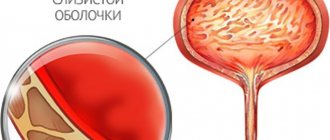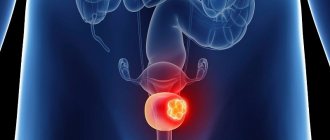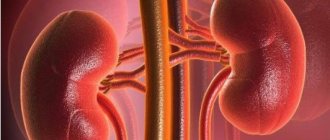Cystitis is an inflammation of the mucous membrane of the bladder. By the nature of its occurrence, it can be infectious or non-infectious, that is, resulting from diseases of the bladder. In urology, this disease is one of the most common and affects 25% of women worldwide, and in 10% of them it occurs in a chronic form.
In men, cystitis occurs 8 times less frequently, which is due to the anatomy of the male genitourinary system. Since women have a much shorter and wider urethra, it is easier for ascending infections to enter the body, so this disease is most often considered to be a female disease.
Lack of treatment or the wrong approach to it can lead to very serious complications, therefore, if you suspect cystitis, the symptoms of which interfere with your normal lifestyle, you should immediately seek medical help at the private clinic “Doctor Anna”.
Cystitis in women - symptoms and treatment
Due to the specific anatomical structure of the genitourinary system - a short and wide urethra and the proximity of the rectum and vagina - cystitis can most often be found in women.
The main signs of cystitis in women are:
- frequent, painful urination;
- feeling of incomplete emptying of the bladder;
- cloudy urine, often mixed with blood;
- pain in the lower abdomen, in the projection area of the bladder;
- low-grade fever with cystitis (up to 37.5℃).
If you have at least two of the listed signs of cystitis, it is recommended to consult a urologist as soon as possible.
Diagnosis is carried out, first of all, on the basis of the patient’s complaints and tests for cystitis - a general urine test. Also, for better information, it is necessary to conduct an ultrasound examination of the bladder and kidneys, and microbiological culture to determine sensitivity to antibiotics.
As an auxiliary diagnostic study, if the doctor has doubts when making a diagnosis, it is possible to perform a cystoscopy, in which the bladder area is viewed through a thin tube at the end of which there is a camera. If necessary, the patient is sent for computed tomography, MRI, and determination of general and biochemical urine analysis.
The following approaches are used in the treatment of cystitis in women:
- Medication. Depending on the specific causes of cystitis in women and based on test results, uroseptics, anti-inflammatory drugs, analgesics and antispasmodics, and herbal uroseptics may be prescribed.
- Physiotherapy. Physiotherapy speeds up the healing process, provides longer remission, and improves the delivery of medications to the affected area.
- Iontophoresis and instillation - intravesical administration of drugs. The use of instillation is recommended only during remission.
- Treatment of concomitant gynecological pathologies.
It is highly not recommended to prescribe any type of treatment for yourself. This can lead to irreparable consequences. Any type of therapy can be prescribed exclusively by the attending physician.
It is worth understanding that having discovered cystitis, treatment is not carried out according to a specific, universal scheme for each patient. Correct treatment depends on what medications the patient took and for how long before seeing a doctor, what effect these medications had, what are the causes of the disease and how long it has been present.
Having examined the visitor and carried out all the necessary tests for cystitis, the doctor, using all the presented methods of therapy, develops an individual approach in each individual case.
Often people, in an attempt to eliminate cystitis on their own, use traditional medicine methods. Preparations based only on herbal components can help get rid of the problem, but only for the recovery period, that is, they do not replace the main treatment, but only complement it.
The use of herbal preparations alone is not capable of destroying the causative agent of the disease, which means that the situation can become chronic or aggravate the course of the disease by moving the ascending infection to the kidney area.
It is important to remember that heating the bladder area during an exacerbation is strictly prohibited. Bacteria multiply at a faster rate as body temperature rises, thus making the problem worse.
Signs of cystitis in women
Signs of cystitis vary and depend on many factors - from the age of the patient, to lifestyle and the type of pathogen.
Symptoms of cystitis are clearly distinguished, which cannot be ignored due to their intensity - severe pain during and at the end of urination, and frequent painful urges.
The appearance of bloody discharge may indicate the presence of an acute inflammatory process.
Cystitis with constant exacerbations leads to problems with sexual life. If cystitis is not treated in time, problems with urine leakage may occur, which significantly worsens a woman’s quality of life.
Diagnostics
Correct diagnosis of cystitis directly affects the success of treatment of the disease. It is important to establish the nature and factors of inflammation before prescribing therapy. If allergic cystitis occurs and contact with the allergen is not eliminated before taking antibiotics, the condition will only worsen.
In the case of infectious cystitis, it is necessary to determine its causative agent and establish which antimicrobial or antifungal drugs it is sensitive to. The result of the study will determine the course of further therapy. If cystitis is non-infectious in nature, it is necessary to conduct an examination to determine the causes that triggered the onset of the disease. Perhaps the cause is urolithiasis or a neoplasm.
Diagnosis of the disease includes the following stages:
- taking anamnesis;
- determination of clinical manifestations;
- appointment of laboratory tests;
- examination using instrumental methods.
Causes
The causes of cystitis can be divided into two groups - anatomical and concomitant. Anatomical reasons are associated with the proximity of the vagina and anus, and, as a consequence, the microflora of the rectum enters the urethral area. There is also no obstacle to the entry of microorganisms from the anal area due to the fact that the urethra of women is short and wide, unlike men.
Among the associated reasons are the following:
- Intense sex life. The number of sexual partners directly depends on the invasion of pathogenic microorganisms into the urethra.
- Features of sexual activity (combination of oral, anal and vaginal sex). If vaginal sexual intercourse occurs after oral or anal intercourse, this provokes the reflux of abnormal flora into the urethral area.
- Hypothermia;
- Concomitant surgical or gynecological pathology. Vaginal infections, infections in the pelvic organs, in the cervix, urolithiasis.
- Decreased immunity;
- Changes in hormonal levels during menopause. Female sex hormones estrogens have immunomodulatory and protective properties. That is why, when the concentration of estrogen in the body decreases during menopause, a woman becomes more vulnerable due to changes in her hormonal profile.
- Disturbance of urine outflow. A situation when a person puts off going to the toilet and endures without emptying the bladder on time.
- Violation of intimate hygiene.
It is extremely rare for patients to have only one cause, most often several are combined at once.
Risk factors
There are many factors that contribute to the development of cystitis:
- hypothermia;
- decreased immunity;
- hypovitaminosis;
- poor nutrition. Spicy, salty, fried, fatty and alcoholic drinks irritate the walls of the bladder and dehydrate the body;
- violation of vaginal microflora;
- frequent and prolonged constipation;
- injuries to the bladder mucosa;
- sedentary lifestyle (poor circulation);
- tight clothing and synthetic underwear;
- the presence of chronic gynecological, urological or sexually transmitted diseases;
- previous urinary tract infections;
- failure to comply with personal hygiene rules;
- improper use of pads and tampons;
- constant lack of sleep, overwork, stress;
- promiscuity and unprotected sex;
- diabetes;
- hormonal disorders;
- previous operations;
- bladder catheterization;
- taking certain medications, for example, sulfonamides;
- genetic predisposition;
- pregnancy and childbirth;
- anatomical abnormalities, for example, phimosis in boys.
What can cystitis be confused with?
It is difficult to give a definite answer to the question of what cystitis can be confused with, because similar symptoms of cystitis in women can be characteristic of a large number of pathologies. But we can highlight the main, most common diseases:
- Urinary dysfunction. Improper functioning of the kidneys leads to impaired blood filtration and urine excretion in small quantities.
- Mechanical damage to the ureter;
- Inflammation of the appendix. In the initial stages, cystitis and appendicitis have similar symptoms. Inflammation causes nagging pain in the lower abdomen, hyperthermia and deterioration in general well-being.
- Urolithiasis disease. Such pain can be caused by crystals located in the kidneys. Over time, small crystals form stones that can begin to move along the ureter and cause severe pain radiating to the perineum.
- Glomerulonephritis. Inflammation of the glomeruli and small blood vessels of the kidneys.
- Pyelonephritis. An infectious and inflammatory disease that affects the pyelocaliceal system and renal parenchyma. The signs of cystitis and pyelonephritis are similar, so a specific disease can be differentiated by a blood test.
- Gynecological pathology. Cystitis is often confused with gynecological diseases. These two conditions of discharge are distinguished - with inflammation of the bladder, white discharge from the urethra may be present, and if a woman finds unhealthy discharge from the vagina, this may be a sign of the presence of pathology of the genital organs.
Hemorrhagic cystitis
Hemorrhagic cystitis or hematuria is characterized by the presence of blood in the urine. Normal urine is straw-yellow in color, which can vary in shades from light to dark depending on the quantity and quality of fluid and food taken.
If the urine is colored red, then most often the reason for this is the presence of blood, that is, hemorrhagic cystitis.
There are many reasons for this disease. Blood can be a consequence of urolithiasis, neoplasms, infections, injuries, anomalies in the development of the genitourinary system, kidney prolapse, kidney cysts, hypertension, glomerulonephritis, taking certain medications, intense physical activity.
Postcoital cystitis
Postcoital cystitis is cystitis that occurs after sexual intercourse due to the low location of the urethra in a woman.
During frictional movements during sexual intercourse, the opening of the urethra is screwed into the vagina and aggressive external microflora enters the urethra, and then into the bladder, causing its inflammation.
The incubation period in this case is short - from several hours to 2-3 days. The woman experiences painful, scanty urination, and a constant feeling of a full bladder.
Treatment of cystitis in women is carried out surgically and non-surgically. During surgery, the urologist increases the distance between the urethra and the entrance to the vagina.
Non-surgical treatment of cystitis in women is based on intimate filling. In this case, in order to change the anatomy of the urethral opening, the doctor uses a dense gel filler based on hyaluronic acid. It is inserted under the urethra, raising the opening above the vaginal opening.
Complications
One of the most common complications is vesicoureteral reflux - urine from the bladder enters the ureter and then into the kidneys, that is, it flows in the opposite direction.
If this process is not stopped, inflammation of the ureter and kidneys occurs, which can lead to inflammation of the uterus and appendages. In advanced conditions, urine accumulates in the kidneys, which provokes peritonitis and inflammation of the peritoneum.
Also, scars and abscesses can often form in the bladder, as a result of which the volume of the bladder decreases, frequent urination appears, and ulcers form.
Another complication is cystalgia, which is associated with inflammation of the nerve endings that innervate the bladder. Trigonitis often occurs - inflammation of the triangle located between the ureter and the urethra.
Other complications include reproductive dysfunction, since prolonged, protracted cystitis, especially in the acute stage, can lead to spontaneous abortion.
Cystitis in men can lead to inflammation of the prostate gland or prostatitis, since the outflow of urine is disrupted and it flows into the prostate gland. The presence of an infection in the bladder also infects the prostate gland, which leads to inflammation of the prostate, and in some cases epididymitis (inflammation of the epididymis).
In advanced cases, paracystitis or inflammation may spread to the pelvic organs. With ulcerative cystitis, deep ulcers form on the mucous membranes; they do not heal for a long time and cause a number of symptoms characteristic of the acute form of this disease.
Which doctor should I contact?
Acute cystitis is usually treated on an outpatient basis, but before that you need to make an appointment with a urologist for examination and quality treatment.
The patient needs bed rest and limited physical activity. Treatment lasts on average from 5 to 7 days. As a medicinal treatment, the doctor prescribes anti-inflammatory, antibacterial therapy, and for painful urination, antispasmodic therapy.
It is recommended to exclude spicy and salty foods and alcohol. You should drink a lot of liquid, cranberry juices, compotes. If necessary, medications are instilled into the bladder.
Instrumental research methods
Among the instrumental methods for diagnosing the disease, the most common is cystoscopy, which involves visualizing the urethra and bladder using a cystoscope. In case of acute cystitis, insertion of instruments into the bladder is contraindicated, since the process is extremely painful and contributes to the spread of infection in the organs of the genitourinary system.
This procedure is only permissible in case of chronic cystitis, the presence of a foreign body in the bladder, or in case of prolonged course of the disease (10-12 days).
In addition to the above procedures, women with cystitis are recommended to undergo an examination by a gynecologist, diagnose sexually transmitted infections, undergo an ultrasound examination of the pelvis, biopsy, uroflowmetry and other studies.
In special cases, cystography is prescribed. This study allows you to see any abnormalities and neoplasms on the walls of the bladder. The procedure uses x-rays. To obtain more accurate results, a contrast agent is injected through a catheter, straightening the organ to expand the field of view. The results are visible on an x-ray.








